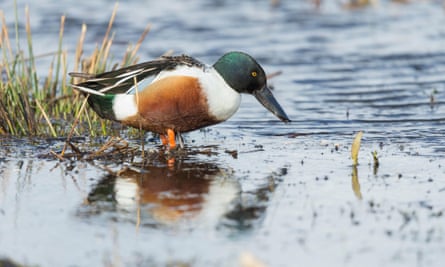
A great white. Not a shark, but a snow-white egret, balancing on the bank while peering into the water for a fish or frog. Once it spies its victim, it draws back its long, curved neck, before darting forward at lightning speed, and spearing the prey with its custard-yellow, dagger-like bill.
I’ve only walked 100 metres or so before I come across this tall, elegant bird, so close even I can get a decent photo. Fortunately, I have plenty of time to enjoy the varied and abundant wildlife of the Avalon Marshes, as this is a relatively short walk, less than 10 km out and back.
I begin at the Avalon Marshes Centre, whose car park and toilets, along with an excellent café and arts and crafts gallery, provide everything the visitor needs. A short walk along the minor road leads me to a narrow entrance, opening out onto the path that runs the entire length of these nature reserves, from Natural England’s Shapwick and Meare Heaths, via Ashcott Corner, to the RSPB’s showpiece reserve at Ham Wall.
These, together with the Hawk and Owl Trust reserve at Shapwick Moor, and Somerset Wildlife Trust reserves at Westhay Moor and Catcott Lows, are collectively known as the Avalon Marshes – a name coined to commemorate the area’s Arthurian heritage.
The path has a history, too. It used to be the Somerset and Dorset railway line, running from Evercreech to the coast at Highbridge Wharf (a posh name for Burnham-on-Sea). Before Dr Beeching closed the line in the mid-1960s, the poet John Betjeman travelled the route for a TV film.
Much as I regret the vandalism Beeching wrought on Britain’s railways, I am secretly thankful that this particular line was closed, as it makes for a lovely walk across the marshes. On sunny summer days, walkers, cyclists, birders and botanists flock to these flatlands, along with hordes of children running happily ahead of their parents. The railway path is flat and not too bumpy, making the walk accessible to anyone with mobility issues.
To avoid the crowds, I take a side-path off the main route, where I soon discover that the history of this area goes back a lot further than King Arthur. The Sweet Track is named after its discoverer, Ray Sweet, who was digging peat here in 1970 when he came across a trackway crossing the marshes. The construction date was later pinpointed to 3807BC, making it almost 6,000 years old – at the time, the oldest known “road” in Britain. Today, I can follow in the footsteps of those ancient marsh-dwellers, and try to imagine what it was like to live in this watery environment.
Peat is the very reason these reserves are here at all. This is far from a timeless landscape; it was formed in the late 20th century, as mechanised peat excavations produced these shallow waterbodies, which were eventually turned into nature reserves. So, although the view may look timeless, it is actually the product of a post-industrial age.
Fortunately, the wildlife doesn’t care whether this landscape is natural or man-made. The combination of open water, mud, reedbeds, and alder and birch woodland attracts a wide range of wild creatures, all year round.
Autumn, on the cusp of change from summer to winter, can be rather quiet. The warblers that arrived here from Africa last spring are now long gone, as are the butterflies, damselflies and dragonflies of summer, and the swifts, swallows and martins that fed in huge flocks here during the warmer months.
Occasionally, a lone swallow might linger into November but, by now, their place is taken by a host of new arrivals from the north and east. On every stretch of open water I come across colourful ducks: wigeon, shoveler and pintail, which have flown here from Iceland, Scandinavia or Siberia. I might also see our two winter thrushes: the large, gangly fieldfare, and its smaller, neater cousin the redwing.
To find these birds, I either scan from the path itself, or head into one of several hides down tracks on either side of the route. These include Noah’s Hide at Shapwick Heath, which gives an elevated view, as does the Avalon Hide, further on at Ham Wall. Here, accessible viewing platforms allow me to scan the reeds for low-flying marsh harriers, and maybe a kingfisher or bittern.
The path itself is usually the best place to stand and wait for the big show: the famous starling murmurations, which take place around dusk from mid-November through to late February. I always check the Starlings Hotline (07866 554142) to find out where the flocks are likely to gather, and get into position at least an hour before sunset, as the birds’ arrival time varies depending on the light and weather conditions.

First-time visitors gasp at flocks of a few hundred starlings, but old-timers like me know this is just the start. At first, the birds gather in their thousands, then tens of thousands, and finally as many as a quarter of a million, swooping and diving in synchronised formation like shoals of fish, making their mind-boggling shapes and patterns.
If I’m lucky, a predator such as a peregrine or sparrowhawk will appear out of nowhere, and try to seize a straggling starling; often, though, they are confused by the sheer mass of birds, and fail in their quest. As dusk falls, the starlings come down to land in the reeds, and start chattering loudly to one another. A few minutes later, they go quiet, and settle down for the night.
As I walk back, I keep looking for birds: bitterns and egrets going to roost, ghostly barn owls hunting low over the reeds, and maybe a woodcock flying jerkily across the darkening sky. On midwinter days, when the show finishes early, I grab a welcome hot drink and snack from the Marshes Hub Tea Stop by the Avalon Marshes Centre, before heading home, leaving the birds in peace.
Stephen Moss is president of the Somerset Wildlife Trust. He leads tours for Somerset Birdwatching Holidays and his “bird biographies” of the robin, wren, swallow and swan are published by Square Peg



